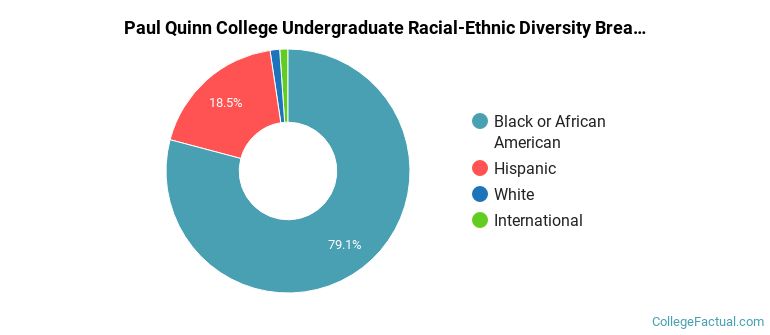 by our College Data Analytics Team
by our College Data Analytics TeamPaul Quinn College total enrollment is approximately 468 students.
Male/Female Breakdown of Undergraduates
The full-time Paul Quinn College undergraduate population is made up of 56% women, and 44% men.

For the gender breakdown for all students, go here.
Paul Quinn College Racial/Ethnic Breakdown of Undergraduates

| Race/Ethnicity | Number |
|---|---|
| Black or African American | 320 |
| Hispanic | 95 |
| International | 6 |
| White | 5 |
| Asian | 1 |
| Native Hawaiian or Pacific Islander | 0 |
| Multi-Ethnic | 0 |
| Unknown | 0 |
See racial/ethnic breakdown for all students.

| Race/Ethnicity | Number |
|---|---|
| Black or African American | 352 |
| Hispanic | 102 |
| International | 6 |
| White | 5 |
| Asian | 1 |
| Native Hawaiian or Pacific Islander | 0 |
| Multi-Ethnic | 0 |
| Unknown | 0 |

There are approximately 265 female students and 203 male students at Paul Quinn College.
Paul Quinn College ranks 619 out of 2,183 when it comes to geographic diversity.
50.49% of Paul Quinn College students come from out of state, and 0% come from out of the country.

The undergraduate student body is split among 13 states (may include Washington D.C.). Click on the map for more detail.

| State | Amount |
|---|---|
| Texas | 51 |
| Illinois | 17 |
| California | 10 |
| Nevada | 7 |
| Arkansas | 2 |
Students from 6 countries are represented at this school, with the majority of the international students coming from Angola, Ghana, and Mexico.
Learn more about international students at Paul Quinn College.
A traditional college student is defined as being between the ages of 18-21. At Paul Quinn College, 64.93% of students fall into that category, compared to the national average of 60%.

| Student Age Group | Amount |
|---|---|
| 18-19 | 176 |
| 20-21 | 161 |
| 22-24 | 96 |
| 35 and over | 38 |
| 25-29 | 35 |
| 30-34 | 10 |
| Under 18 | 0 |
Footnotes
*The racial-ethnic minorities count is calculated by taking the total number of students and subtracting white students, international students, and students whose race/ethnicity was unknown. This number is then divided by the total number of students at the school to obtain the racial-ethnic minorities percentage.
References
Department of Homeland Security Citizenship and Immigration Services
Read College Factual's Diversity Ranking Methodology.